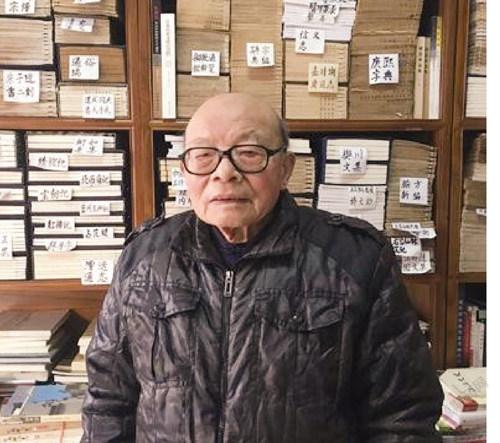LI Wuwei
◆Abstract:OV word order is an important language phenomenon in old Chinese. Scholars have made a lot of researches on OV word order, including studies on OV word order types. Upon the analysis of old Chinese, OV word order was found to first appear in oracle bone inscriptions. Therefore, this paper mainly analyzes OV word order types in oracle bone inscriptions, bronze inscriptions as well as inscriptions other than oracle bone and bronze inscriptions.
◆Keywords:Old Chinese; OV word order; Oracle bone inscriptions; Bronze inscriptions; Type
Word order is an indispensable part of the linguistic typology. OV word order is an important language phenomenon in old Chinese, and its earliest study can be traced to Ma shi wen tong, a book published at the end of the 19th century. The current studies have focused on OV word order types, evolution, origin and evolution mechanism. This paper only looks at OV word order types in old Chinese through the analysis based on oracle bone inscriptions, bronze inscriptions and in inscriptions other than oracle bone and bronze inscriptions.
1 OV Word Order Types in Oracle Bone Inscriptions
Guan Xiechu was the first scholar to study OV word order types in oracle bone inscriptions. In the book A Study on the Grammar of Oracle Bone Inscriptions from the Yin Dynasty Ruins, Guan pointed out that if there was a negative adverb in the sentence that used the pronoun as the object, the pronoun must be placed before the verb. Guan also stated that when an object preceded the transitive verb, there must be a pronoun “叀 zhuan” or “隹 zhui” placed before the object as the case-marker [1]. In his book The Grammar of Oracle Bone Inscription, Zhang Yujin divided prepositive objects in oracle bone inscriptions into three types:
the first type was the prepositive object pronoun with the negative word; the second was the prepositive object in “唯wei - object - verb” or “惠hui - object - verb” word order; the third was the prepositive noun object, such as “王其兕獲 wang qi si huo ” (“兕” is the noun object placed before the verb “获” ) from The Collection of Oracle Bone Inscriptions 28407 [2]. Recently, based on the previous studies, Qi Hangfu discussed five types of prepositive objects in Chapter One Object Preposition of the book A Research on Oracle Bone Inscriptions Word Order, including prepositive objects coupled with “惠”, prepositive objects coupled with “唯”, prepositive object pronouns in negative sentences, prepositive noun objects in negative sentences, as well as prepositive noun objects in affirmative sentences [3]. Meanwhile, Qi devoted a chapter in his book to discuss prepositive noun objects in affirmative sentences, resolving the disagreement once held within the academia. He made by far the most comprehensive, detailed and in-depth classification of the object preposition in oracle bone inscriptions. Based on the above-mentioned studies, OV word order types in oracle bone inscriptions can be summarized as follows:
prepositive object pronouns in negative sentences, prepositive objects coupled with “唯” or “叀” in “唯/叀 - object- verb” word order, and noun objects placed directly before the verbs.
2 OV Word Order Types in Bronze Inscriptions
The earliest study on OV word order types in bronze inscriptions of the Western Zhou Dynasty (1046-771 B.C.) was made by Guan Xiechu. In his book A Study on the grammar of Bronze Inscriptions of the Western Zhou Dynasty, Guan summarized OV word order types in bronze inscriptions of the Western Zhou Dynasty, which included prepositive object pronouns in negative sentences, “唯 - object - 是 shi/之zhi - verb” word order and OV with interrogative pronouns as the objects [4]. Besides, Guan also pointed out the irregular phenomenon of object inversion. In the example of “民献有十夫予翼 min xian you shi fu yu yi” from Da Gao of the Books of Documents, the pronoun was directly placed before the verb. Since the 21 century, Zhang Yujin and Pan Yukun are the leading scholars in terms of OV word order types in bronze inscriptions. In the fifth chapter of A Study on Chinese Grammar of Western Zhou Dynasty, Zhang Yujin divided the prepositive objects in Chinese language during the Western Zhou Dynasty into two types, including sentences with regular word order and sentences whose components break the general word order [5]. The former included prepositive object pronouns in negative sentences, prepositive interrogative pronouns functioning as the objects and “是” as the objects placed before the verb, while the latter included word order types such as “唯 - O - V” and “唯 - O - 是/之 - V”. Guan and Zhangs analyses were mainly based on literature handed down from the Western Zhou Dynasty. Pan Yukun stated discussed “special word order” in the eighth chapter of A Study on the Word Order of Bronze Inscriptions of the Western Zhou Dynasty, and stated four cases of regular object preposition in inscriptions on metalware of the Western Zhou Dynasty, which included pronouns such as “是/之” used as the objects, “唯 - O - 是 - V” OV word order, objects positioned before verbs by dint of “于yu”, and “唯- O - V” OV word order [6]. For sentences with irregular OV word order (e.g, “萬年疆无 wan niang jiang wu”), Pan pointed out that negative sentences with prepositive object pronouns which were seen frequently in literature handed down from the ancient times, were never seen in inscriptions on metalware of the Western Zhou Dynasty. Pans book had a focus on prepositive objects in inscriptions on metalware of the Western Zhou Dynasty. In a word, although they used different corpora, the above-mentioned three scholars made sound analyses of the prepositive objects in bronze inscriptions of the Western Zhou Dynasty.
There are six types of object preposition in Bronze inscriptions of the Western Zhou Dynasty, including prepositive object pronouns in negative sentences, prepositive object pronouns in interrogative sentences, pronouns (e.g, “是” , “予”, etc) placed before the verbs, objects positioned before verbs by dint of “是” , “之” and “于”, “唯 - O - V” OV word order as well as “唯 - O - 是 - V” OV word order.
3 OV Word Order Types in Inscriptions other than Oracle Bone and Bronze Inscriptions
The researches on OV word order types in inscriptions other than oracle bone and bronze inscriptions were centered on grammar works. The research results are as follows.
The leading scholars include Ma Jianzhong, Wang Li, Yang Bojun and He Leshi. In Ma shi wen tong, it was stated that interrogative pronouns in prepositional phrases were always placed before the verbs and rarely placed after the verbs. Normally, the objects were positioned after the verbs, but when there were negative words before the verbs, the objects needed to be placed before the verbs. Or when the subjects were “莫mo” or “无 wu” and the objects were pronouns, the objects were to be positioned before the verbs. Besides, whenever the objects were placed before the verbs, such sentences were inverted. In addition, when a negative word or interrogative word was placed before the verb, “之” would be inserted in the sentence; when the sentence had a affirmative tone, “是” would be inserted in the sentence [7]. Mas perspectives can be summarized as follows. In interrogative sentences, interrogative pronouns functioning as the objects, can be placed before the verbs. In negative sentences, pronouns used as objects can be positioned before the verb. In declarative sentences, objects can be placed before verbs by dint of “是” or “之”. Ma is the first scholar to classify OV word order in old Chinese. His book is pioneering, and his contributions in this area cannot go unnoticed. However, the classification is not comprehensive enough, because a few OV word order types are not included in it.
In the 1950s, Wang Li divided the OV word order in old Chinese into three types [8].
The first type was completely free of the old form, and only a few remnants of the old form were preserved. For instance, object pronouns can be directly placed before the verbs, such as “民獻有十夫予翼” from Da Gao of the Books of Documents and “是顾是复 shi gu shi fu” from Daya Sangrou of The Book of Songs.
The second type kept the old form completely, which was dependent on two conditions. Firstly, the object in this type was an interrogative pronoun, such as “吾谁欺 wu shui qi” (in which “谁” is the interrogative pronoun placed before the verb “欺”) in The Analects of Confucius:
Zihan. Secondly, when the object was a noun with a demonstrative pronoun, such as “日居月诸,下土是冒 ri ju yue zhu, xia tu shi mao” (in which “下土” is a noun with “是” as the demonstrative pronoun placed before the verb) in the poem Beifeng Riyue from The Book of Songs.
In the third type, the old and the new forms co-existed. The most obvious case in point was the object pronoun in the negative sentence, such as “鄰国未吾亲也 lin guo wei wu qin ye” (in which “吾” is the object pronoun placed before the verb “亲” and “未” is the negative word) stated in Discourses of the State of Qi.
At the end of the 20th century, Yang Bojun and He Leshi, in the book The Grammar and Development of Old Chinese, divided sentences with prepositive objects into two types. In the first type, objects were placed directly before the verbs without adding structural particles. In the second type, objects were placed directly before the verbs by adding structural particles. The first type was seen in negative, interrogative and affirmative sentences, while the second type involved the use of structural particles, such as “是” , “之”, “焉 yan” and “斯 si” [9]. This book classified OV word order types both scientifically and comprehensively, with ample examples and detailed description, and it also provided sound explanations for the confusion about the different word order types. The book is by far the most in-depth and detailed analysis of OV word order. It can be seen that the OV word order types in inscriptions other than oracle bone and bronze inscriptions are the same as that in bronze inscriptions.
4 Conclusion
This paper looked at OV word order types in oracle bone inscriptions, bronze inscriptions and inscriptions other than oracle bone and bronze inscriptions. OV word order types in oracle bone inscriptions included prepositive object pronouns in negative sentences, prepositive objects coupled with “唯” or “叀” in “唯/叀-object-verb” word order, and noun objects that placed directly before the verbs. In bronze inscriptions and inscriptions after the Western Zhou Dynasty, objects in negative sentences, objects coupled with “是” or “之”, and object pronouns were all placed before the verbs, and the word order type in which the nouns were positioned before the verbs disappeared.
Works Cited
[1]Guan Xiechu.“A Study on the Grammar of Oracle Bone Inscriptions from the Yin Dynasty Ruins”.Beijing:
Science Press,1953.
[2]Zhang Yujin.“The Grammar of Oracle Bone Inscription ”.Shanghai:Xuelin Publishing House,2001.
[3]Qi Hangfu.“A Research on Oracle Bone Inscriptions Word Order”.Shanghai Zhongxi Book Company,2015.
[4]Guan Xiechu.“A Study on the Grammar of Bronze Inscriptions of the Western Zhou Dynasty”.Beijing:
The Commercial Press,1981.
[5]Zhang Yujin.“A Study on Chinese Grammer of Western Zhou Dynasty”.Beijing:
The Commercial Press,2004.
[6]Pan Yukun.“A Study on the Word Order of Bronze Inscriptions of the Western Zhou Dynasty”.Shanghai:
East China Normal University Press,2005.
[7]Ma Jianzhong.“Ma shi wen tong”. Beijing:
The Commercial Press,1898.
[8] Wang Li.“Manuscript of Chinese History”. Beijing:
Science Press,1957.
[9]Yang Bojun,He Leshi.“The Grammar and Development of Old Chinese”.Beijing:
Language&Culture Press, 2001.
Personal profile
Li Wuwei (1977.02—), male, Chengdu, Sichuan, Chinese, Ph.D. candidate; research direction:
ancient Chinese grammar.




